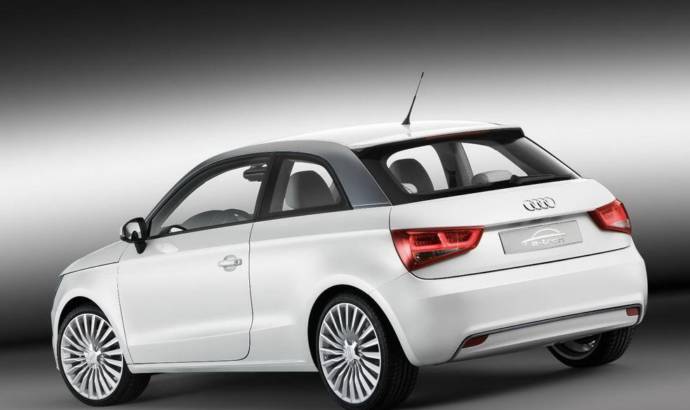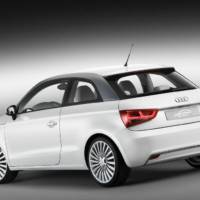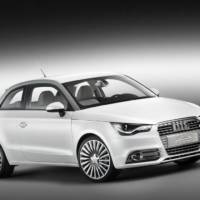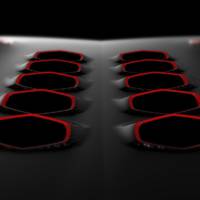The German automaker has published the Audi A1 e-tron specs as 20 exemplars of its extended range electric A1 are going test trial around Munich.
The city of Munich will provide 200 electric filling stations enabling each of the 20 Audi A1 e-tron cars to recharge, and this testing process will continue until mid-2011.
The Audi A1 e-tron specs indicate that the automaker’s small electric car is able to produce 102 PS and when running in pure electric mode by using the lithium-ion battery battery pack, it can cover 31 miles, or 124 miles when it uses the 15 kW range extender.
The Audi A1 e-tron has a top speed of 81 mph, can return 149 mpg and has CO2 emissions of 45g/Km.
Audi press release:
examples of the advanced all-electric Audi A1 premium compact hatchback are set to take to Munich’s streets in pilot project
* 20 Audi A1 e-trons will be on trial in Munich and its environs by mid-2011as part of a project undertaken by Audi AG, E.ON, Stadtwerke München and the Technical University of Munich
* 200 ‘electric filling stations’ to be built to deliver ‘green electricity’
* Audi A1 e-tron – 102PS, top speed 81mph, equivalent ‘fuel economy’ using range extender 148.7mpg, equating to 45g/km CO2 output
Munich’s electricity supply is about to spark 20 road-ready Audi A1 e-trons into life on the German city’s streets as part of an exciting pilot project undertaken by Audi AG in partnership with E.ON, the Munich municipal utility company Stadtwerke München (SWM) and the Technical University of Munich (TUM).
All 20 examples of the innovative battery-powered ‘Mega City vehicle’ (MCV) will be operational by mid-2011 as participants in the "eflott" project, which forms part of the "Model Region Electromobility Munich" initiative sponsored by the German Federal Ministry of Transport. ‘Fuelled’ by 200 newly installed charging stations, they will enable experts to address a number of issues, from the data transfer between the driver, vehicle and electric filling station to the power grid and the use of smartphones as the central interface for the driver.
Delivering an output equivalent to 102PS, the lithium-ion battery mounted within the floor assembly in front of the rear axle of the A1 e-tron powers it to a top speed of 81mph and gives it a range of more than 31 miles in city traffic. From start up it is classified as a zero emissions vehicle over this distance. A compact internal combustion engine recharges the battery when its energy is depleted.
A small, single-rotor Wankel engine in this near-series production vehicle increases the range in exceptional circumstances. This “range extender” powers a generator that produces 15 kW of charging power. If the range extender is used to recharge the battery, the A1 e-tron can cover an additional 124 miles. According to a draft standard for the calculation of fuel consumption for range extender vehicles, this represents a fuel economy figure of 148.7mpg, equating to a CO2 output of only 45 g/km.
E.ON and SWM are installing the necessary charging infrastructure; E.ON primarily in the outlying areas and SWM in the Bavarian state capital. The two utility companies are initially installing a total of 100 “electric filling stations” each as part of a variety of projects. All of the charging stations are supplied with electricity generated from renewable energies.
The Technical University of Munich is responsible for comprehensive data collection and evaluation of mobility behaviour. Its experts will monitor how heavily and in which situations the electric car being used, and what influence this option has on the use of other means of transportation.
To answer these questions, the Department of Vehicle Engineering has developed a mobile application that will be provided on a smartphone to all participants of the fleet trial. The device will thoroughly document their mobility behaviour – from their use of bicycles to the electric cars and from conventional cars to buses and trains. To ensure that the participants always use the smartphone, the Department of Ergonomics made sure that the application features an easy-to-use design that encourages use over the long-term. At the same time, the Department of Marketing is conducting a study to discover which billing models for the electricity used for e-mobility meet with the greatest acceptance.
The fleet trial is being supported by the German Federal Ministry of Transport as part of a publically-funded project. Federal Transport Minister Peter Ramsauer comments: “Electromobility is not an abstract technology issue. At its core is the question of how the transportation systems of the future should look. We are therefore funding electromobility under real-world conditions in our model regions – a large field test, so to speak. Projects like these provide us with important insight into how to make electromobility a success, both in the city and in rural areas. In the Munich model region, we are providing approximately €10 million in funding for electromobility. This money is a smart investment in the future. Our goal is clear: We want to make Germany the lead market for electromobility and put at least one million electric vehicles on German roads by 2020.”
“Audi is working hard on the future of mobility. “We are trying to find a concept that requires no compromises,” says Rupert Stadler, Chairman of the Board of Management of AUDI AG, who continues, “Electromobility means more to us than just electrifying conventional cars. Instead we are dedicated to a holistic approach to all aspects of the topic. We hope that this fleet trial will enable us to gain broad insights into the behaviour but also the expectations of our customers regarding their dealings with electric cars. Of course, the data that we will collect are another aspect. This market and technology feedback will enable us to further expand our expertise in electrification.
Klaus-Dieter Maubach, Member of the Board of Management of E.ON AG, Technology, adds, “In this project, we are shifting the locations of our electric filling stations to existing parking lots as was suggested by our knowledge of user behaviour. We are equipping private garages or parking garages, for example, with charging stations. We hope that this will allow us to further develop the technology of the charging points and the communication with the grid operator, in particular, and thus secure our leadership role in the development of electric filling stations. Intelligent charging points are more than just electric filling stations. They are the prerequisite for using vehicle batteries as intermediate storage for renewable energies in the intelligent power grids of the future.”
As an operator of subways and trams, SWM has decades of experience with electric mobility in short-range public transport. The expansion of the charging infrastructure marks their entry to the field of sustainable individual mobility. “The SWM charging stations will ‘pump’ nothing but our green electricity," says Dr. Florian Bieberbach, Commercial Director of SWM, reducing the vehicles’ CO2 emissions to zero. Our efforts to expand renewable energies are providing the foundations that allow us to do this. By 2025, we hope to generate enough green electricity in our own plants to meet the electricity needs of the entire population of Munich – including the requirements of electric vehicles. This would make Munich the first city of over one million inhabitants to achieve this ambitious goal.”
“For researchers, it is no longer a question of whether electric mobility will be able to establish itself, but rather of when. Electromobility means a paradigm shift for industry and society, making it a central strategic focus of the TUM,” says Professor Wolfgang A. Hermann, President of the Technical University of Munich. “The Science Center for Electromobility at TUM pools the expertise of 42 departments from eight schools, which are working hard to contribute to the development of sustainable individual mobility.”

15 Sep 2010
0




